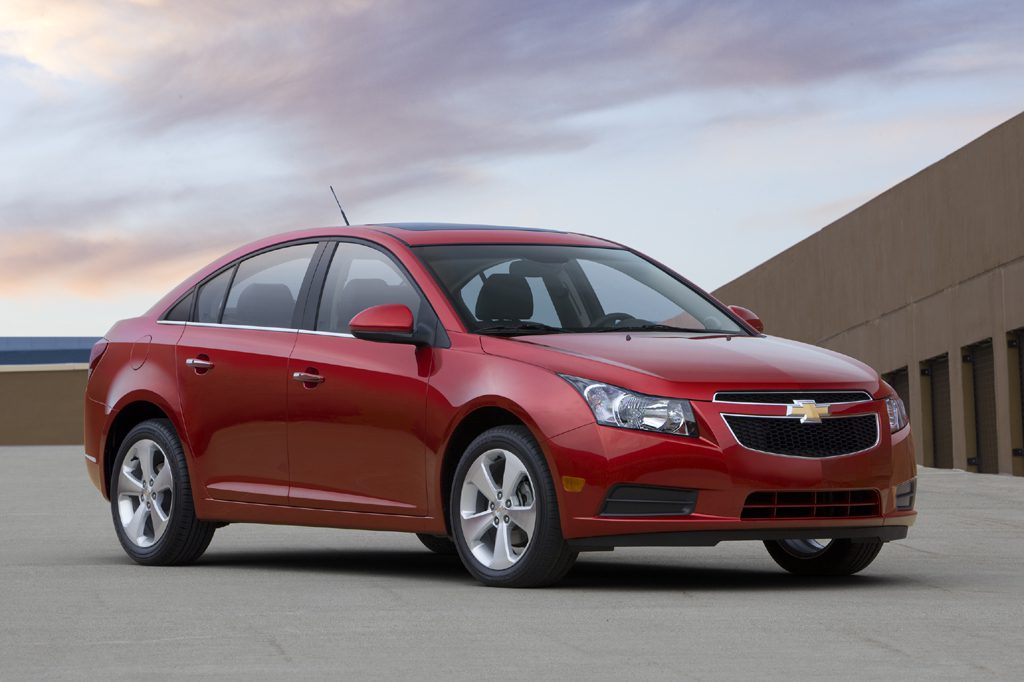| Compact car; Built in USA |
|
|
| Good condition price range: $6,000 – $18,300* |

2011 Chevrolet Cruze Front

2011 Chevrolet Cruze Rear

2011 Chevrolet Cruze Profile

2011 Chevrolet Cruze Interior
| Pros: |
|
| Cons: |
|
Chevrolet’s latest compact sedan represents itself very well in a crowded and highly competitive market segment. Engines are smooth and offer good power for most everyday driving situations. The Eco edition delivers excellent fuel economy with little compromise of this car’s other virtues. Interior comfort, especially in the front seat, is very good. Interior appearance scores solidly among the class leaders. On the road, Cruze feels substantial and refined. Cruze’s list of standard safety features also is compelling. Chevrolet has produced a well-rounded compact sedan that holds its own with the best entries in this class. If you are shopping among compacts, the Recommended (2011-12) Cruze should certainly be on your shopping list, new or used.
Overview
For 2011, the brand-new Chevrolet Cruze replaced the prior Cobalt as the compact car from General Motors’ volume division. Cruze was a four-door sedan that came in LS, LT, LTZ, and fuel-economy-oriented Eco trim levels. LT models were further subdivided into 1LT and 2LT editions. The LS had a 136-horsepower, 1.8-liter four-cylinder engine. The 1LT, 2LT, LTZ, and Eco models used a turbocharged 1.4-liter four-cylinder engine that produced 138 horsepower. A six-speed manual transmission was standard on the LS and Eco. A six-speed automatic was optional on those models and standard on the LT and LTZ. Standard safety features included antilock braking, traction control, an antiskid system, curtain side airbags, front and rear side airbags, and front knee airbags. Chevrolet claimed Cruze was the only car in its class with 10 standard airbags. Cruze Eco models had ultra-low-rolling-resistance tires and other aerodynamic tweaks that aimed to increase fuel economy. Available on the LT and LTZ was an RS Appearance Package, which included fog lights and specific exterior trim. Leather upholstery, heated front seats, remote engine start, and a wireless cell-phone link were standard on the 2LT and LTZ. A sport suspension was standard on the LTZ. Rear-obstacle detection was optional on the LT and standard on the LTZ. Chevrolet’s Cruze competed against such compacts as the Ford Focus, Honda Civic, and Mazda 3, as well as the Toyota Corolla, Hyundai Elantra, and Nissan Sentra.
Yearly Updates
| 2012 Cruze The 2012 Chevrolet Cruze got a few tweaks to standard and optional features, and EPA fuel-economy estimates for some models improved slightly. Also, while many automakers were cutting availability of manual transmission, Chevrolet made a manual gearbox standard on more of its Cruze versions. Cruze became Chevrolet’s best-selling car, both in the U.S. and around the world. |
| 2013 Cruze Cruze saw some trim and feature updates. Most versions could be equipped with Chevrolet’s MyLink infotainment system. New for 2013 was an Enhanced Safety Package, which included rear-obstacle detection, blind-spot alert, and rear cross-traffic alert. Cruze LS models sold in California and several northeastern states included an engine that allowed the car to achieve Partial Zero Emissions Vehicle status. |
| 2014 Cruze For 2014, Cruze gained an available 151-horsepower 2.0-liter turbodiesel engine that was capable of an EPA estimated 46 mpg highway. |
| 2015 The 2015 Chevrolet Cruze got an updated front styling and the following connectivity features: Text Message Alerts, Siri Eyes Free functionality for Apple iPhone users, and OnStar with 4G LTE Internet connectivity with a built-in Wi-Fi hotspot. Cruze was redesigned for 2016. |
